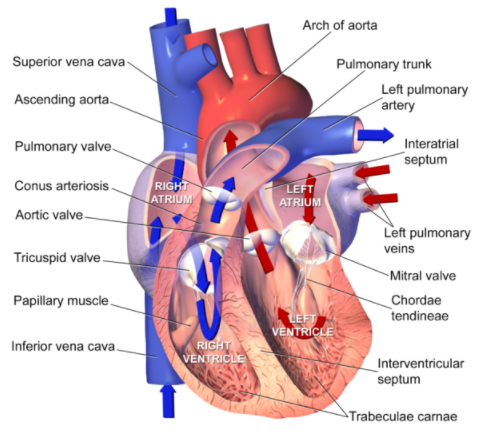
Contraction of right ventricle pumps blood into the
A. Dorsal aorta
B. Pulmonary artery
C. Pulmonary veins
D. Coronary artery
Answer
511.8k+ views
Hint: In human beings,the left half of the heart is related with the circulation of oxygenated blood while the right half is related to the circulation of deoxygenated blood.
Complete answer:
Our heart consists of four chambers out of which the two relatively small upper chambers are called atria or auricles while the two relatively larger lower chambers are called ventricles.
If we consider the heart in two parts as left and right each half will have one auricle and one ventricle named as the right auricle,right ventricle,left auricle and left ventricle.
The left auricles receives oxygenated blood from the lungs through the pulmonary vein and this oxygenated blood is pumped by the left ventricle in all parts of the body through the pulmonary vein and this oxygenated blood is pumped by the left ventricles in all parts of the body through the dorsal aorta.
From the body parts, the right auricles receive deoxygenated blood through vena cava and this deoxygenated blood through vena cava and this deoxygenated blood is pumped to the lungs by the right ventricle through the pulmonary artery. Hence the blood is made oxygenated through gaseous exchange and is then circulated through the heart again.
Therefore, the right ventricle is found in the lower right side of the heart which is opposite to the left ventricle. As deoxygenated blood starts its flow into the right atrium and it moves through the tricuspid valve and at last into the right ventricle which pumps the blood up with the help of pulmonary valve and through pulmonary artery to lungs.

Hence, the correct answer is option (B).
Note: The human circulatory system is also known as double circulation as there are two pathways involved in the complete circulation of the blood throughout the body. One is the pulmonary pathway that is between the heart and lungs and the other is the systematic pathway that connects the heart to the rest of the body part.
Complete answer:
Our heart consists of four chambers out of which the two relatively small upper chambers are called atria or auricles while the two relatively larger lower chambers are called ventricles.
If we consider the heart in two parts as left and right each half will have one auricle and one ventricle named as the right auricle,right ventricle,left auricle and left ventricle.
The left auricles receives oxygenated blood from the lungs through the pulmonary vein and this oxygenated blood is pumped by the left ventricle in all parts of the body through the pulmonary vein and this oxygenated blood is pumped by the left ventricles in all parts of the body through the dorsal aorta.
From the body parts, the right auricles receive deoxygenated blood through vena cava and this deoxygenated blood through vena cava and this deoxygenated blood is pumped to the lungs by the right ventricle through the pulmonary artery. Hence the blood is made oxygenated through gaseous exchange and is then circulated through the heart again.
Therefore, the right ventricle is found in the lower right side of the heart which is opposite to the left ventricle. As deoxygenated blood starts its flow into the right atrium and it moves through the tricuspid valve and at last into the right ventricle which pumps the blood up with the help of pulmonary valve and through pulmonary artery to lungs.

Hence, the correct answer is option (B).
Note: The human circulatory system is also known as double circulation as there are two pathways involved in the complete circulation of the blood throughout the body. One is the pulmonary pathway that is between the heart and lungs and the other is the systematic pathway that connects the heart to the rest of the body part.
Recently Updated Pages
Master Class 11 Business Studies: Engaging Questions & Answers for Success

Master Class 11 Computer Science: Engaging Questions & Answers for Success

Master Class 11 Maths: Engaging Questions & Answers for Success

Master Class 8 Science: Engaging Questions & Answers for Success

Master Class 10 Computer Science: Engaging Questions & Answers for Success

Master Class 10 Social Science: Engaging Questions & Answers for Success

Trending doubts
1 ton equals to A 100 kg B 1000 kg C 10 kg D 10000 class 11 physics CBSE

Difference Between Prokaryotic Cells and Eukaryotic Cells

One Metric ton is equal to kg A 10000 B 1000 C 100 class 11 physics CBSE

What is the opposite of entropy class 11 chemistry CBSE

Proton was discovered by A Thomson B Rutherford C Chadwick class 11 chemistry CBSE

Draw a diagram of nephron and explain its structur class 11 biology CBSE




